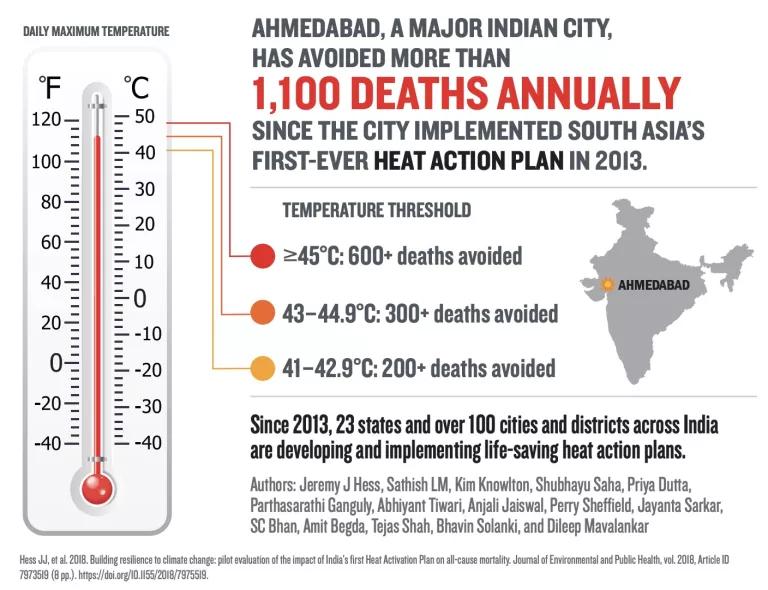Expanding Resilience to Fight Brutal Heat Across India

Temperatures in India are reaching unprecedented levels. With readings in northern India topping 48°C (118.4°F), there is much action needed on extreme heat and climate change with World Environment Day coming up this week.
Brutally hot weather is a major health threat in India and many other parts of the world because climate change is fueling more frequent, intense, and longer heat waves. In response to this mounting threat, cities and regions across India are taking concrete actions to build resilience and better prepare and protect communities.
Strong action is accelerating at the city, state, and national levels to implement extreme heat warning systems and preparedness plans through Heat Action Plans (HAP). NRDC and our partners are highlighting new research that shows how heat action plans can help avoid heat-related deaths as well as an updated issue brief on expanding resilience to extreme heat across India.
Heat Risks Are Rising
Heat is not merely an inconvenience; it kills. Symptoms of heat-related illness include vomiting, headaches, dehydration, and diarrhea. Staff in hospitals, cooling centers, and city infrastructure often struggle to keep communities cool and healthy. The number of high-temperature days in India has increased over the past fifty years, and especially since the 1990s, in highly-populated cities like Mumbai, Delhi, Chennai, Jaipur, and Visakhapatnam.
This season, rural India is especially hard hit by the heat, along with new areas that have not historically been prone to heat waves, such as Kerala. Reports indicate that a lack of drinking water and water tankers is proving lethal. With the late monsoon, families are working to save water by limiting laundry and bathing. Water shortages are brutal for human health as well as livestock, agriculture, and economic prosperity. Despite the earnest efforts by the India Meteorological Department (IMD), National Disaster Management Authority (NDMA) and partners to issue early warnings since February, this heat season came early, is staying longer, and is more severe. Communities are struggling to keep pace with the more intense and more severe hot temperatures that scientists, including the Intergovernmental Panel on Climate Change (IPCC), have forecast.
Scaling Up Heat Action Plans to Protect Public Health
NDMA is leading India’s efforts to better coordinate and equip states to prepare for and respond to the risks posed by extreme heat. NDMA supports state and city level heat action plans (HAP), which identify and coordinate concrete local heat response interventions. As our new fact sheet illustrates, HAPs have expanded widely since first deployed in 2013, to now reach 23 states and over 100 cities and districts through the collaboration of NDMA, IMD, and partners including the Indian Institute of Public Health-Gandhinagar and NRDC.
Key elements of Heat Action Plans often include:
- Building public awareness and community outreach to communicate the risks of heat waves and implement practices to prevent heat-related deaths and illnesses.
- Initiating an early warning system and inter-agency coordination to alert residents of predicted high and extreme temperatures.
- Special programs focused on heat-vulnerable communities, including programs for targeted communication and resilience efforts, such as providing drinking water and cool roofs.
- Capacity building among health care professionals to recognize and respond to heat-related illnesses, particularly during extreme heat events.
- Reducing heat exposure and promoting adaptive measures by mapping high-risk areas, increasing outreach and communication on prevention methods, expanding access to potable drinking water stations and cooling spaces during extreme heat days.
To support HAP implementation, NDMA convenes annual workshops on heat preparedness and develops program monitoring and management strategies with local officials and key experts. At the national level, NDMA facilitates ministerial engagement through regularly updated Heat Guidelines (first released in 2016) that identify short, medium and long term exposure mitigation efforts, including resilient infrastructure planning.
New Evidence That Heat Action Plans Save Lives
New research demonstrates that expanding heat resilience efforts on the ground could save thousands of lives in India. A groundbreaking study evaluating Ahmedabad’s HAP shows how adaptations can substantially reduce population vulnerability to extreme heat. Ahmedabad is one of India’s largest cities that regularly experiences extremely hot weather, including a deadly 2010 heat wave that killed more than 1,300 people and motivated the city to develop South Asia’s first HAP. This plan included a forecast-based heat wave early warning system, epidemiological analysis to determine appropriate warning thresholds, public outreach to explain heat-health risks and protective strategies, and training aimed at health professionals who diagnose and treat heat-related illnesses.

In order to gauge the impact of Ahmedabad’s HAP, experts compared citywide summertime death rates on especially hot days both before and after the plan’s implementation. The study team found that Ahmedabad avoided more than 1,100 deaths each year after implementing its HAP in 2013.
Extreme heat warnings, a key part of Ahmedabad’s HAP, were associated with decreased summertime all-cause mortality rates, with the largest declines at the highest daily maximum temperatures. This is one of the few studies anywhere to evaluate the public health effects of climate adaptation projects, like HAPs, since many of those projects have been launched only recently. The study by public health and municipal authorities in India, academic environmental health researchers in the U.S., and the Natural Resources Defense Council (NRDC) was published in the peer-reviewed scientific Journal of Environmental and Public Health.
Scaling Up Actions on Heat
As climate change continues to fuel brutal heat waves worldwide, effective public health response strategies are more important than ever before. India’s leading efforts to prepare populations for extreme heat provide a path forward for this global challenge. Drawing on the strengths of local leadership, efficient interagency coordination, scientific expertise, robust communication strategies, and effective community engagement, strong action on heat preparedness can deliver lifesaving benefits.
Key Resources
- Expanding Heat Resilient Cities Across India - Issue Brief
- Building Resilience to Climate Change: Pilot Evaluation of the Impact of India’s First Heat Action Plan on All-Cause Mortality’
- Ahmedabad Heat Action Plan (2019 Update)
- City Resilience Toolkit: Response to Deadly Heat Waves and Preparing for Rising Temperatures
- YouTube Clips on the Ahmedabad Heat Action Plan
- CNN Innovative Cities – Ahmedabad Cool Roofs Feature




